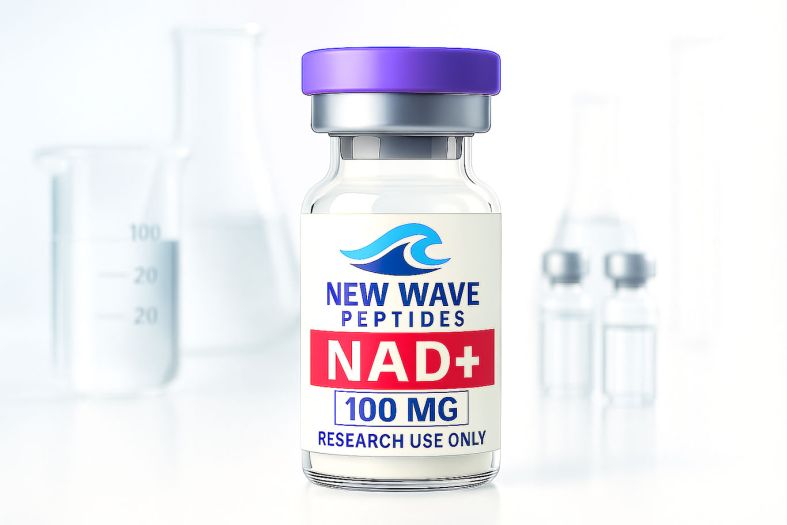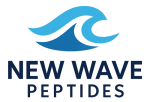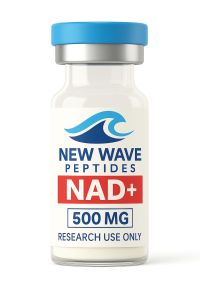
How Researchers Use NAD⁺ in Lab Studies — And How It Compares to NMN
NAD⁺ (Nicotinamide Adenine Dinucleotide) is a crucial molecule involved in energy metabolism, cellular repair, and aging-related processes. Its role in cellular respiration and mitochondrial function has made it a major focus in anti-aging and metabolic research. Alongside NAD+, researchers are also studying its precursors like NMN (Nicotinamide Mononucleotide) to evaluate the most effective ways to support intracellular NAD+ levels in various lab models.
This article explores how NAD+ is used in laboratory studies, how it compares to NMN, and what scientists are discovering about these important molecules.
Note: NAD+ and NMN are sold strictly for laboratory research use only and are not intended for human consumption.
What Is NAD+?
NAD⁺ is a coenzyme found in all living cells. It plays a central role in numerous biological processes including:
- Cellular energy production via oxidative phosphorylation
- Activation of sirtuins (longevity-related enzymes)
- DNA repair and epigenetic signaling
- Regulation of circadian rhythms and inflammation
Its levels naturally decline with age, which has led to growing interest in understanding how to restore NAD+ in aging-related research models.
How Researchers Use NAD+ in Lab Studies
NAD⁺ is studied across a wide range of disciplines, from neurobiology and metabolic disease to skin aging and mitochondrial dysfunction. In in vitro and animal models, researchers examine NAD+'s impact on:
- Mitochondrial efficiency: Enhanced ATP production in aging cells
- Neuroprotection: Reduction of oxidative stress in brain and spinal cord injury studies
- Cellular repair: DNA damage response pathways, including PARP and sirtuin activity
- Metabolic balance: Insulin sensitivity, fatty acid oxidation, and inflammation in high-fat diet models
Animal studies often involve NAD⁺ injections or administration via osmotic pumps to monitor systemic effects on energy levels and lifespan extension.
Laboratory Handling of NAD+
Pure NAD+ is typically provided as a fine white powder. It is water-soluble and light-sensitive, requiring care in storage and handling.
Storage Recommendations:
- Lyophilized NAD+: Store at -20°C in a dry, light-protected container
- Reconstituted NAD+: Use sterile water or PBS; store at 2–8°C and use within 3–7 days
- Avoid: exposure to air, light, and repeated freeze-thaw cycles
What Is NMN and How Is It Different?
NMN (Nicotinamide Mononucleotide) is a direct precursor to NAD+. When administered in lab studies, NMN is converted into NAD⁺ inside the cell, supporting similar biological functions. However, it differs in a few key ways:
| Feature | NAD⁺ | NMN |
|---|---|---|
| Molecular Role | Coenzyme directly involved in metabolic reactions | Precursor to NAD⁺ |
| Cell Entry | Requires specific transporters | Enters cells more readily via NMN transporters |
| Stability | Less stable in solution | More stable, longer shelf life |
| Research Use | Direct testing of NAD⁺ availability and mitochondrial response | Exploring conversion efficiency and bioavailability in tissues |
Why Researchers Choose NAD+ Over NMN
Some laboratories choose to study NAD+ directly for more controlled and immediate evaluation of its biochemical effects. By bypassing the conversion step required with NMN, researchers can test how exogenous NAD+ affects cells and systems more precisely.
This approach is useful in research involving:
- Acute energy failure models (e.g., ischemia-reperfusion studies)
- Brain injury and neuroinflammation
- Direct mitochondrial intervention
Product Integrity and Purity
At New Wave Peptides, we provide high-purity NAD+ powder for research use, tested by HPLC and mass spectrometry. Our NAD+ 500mg vials are designed for consistent results in rigorous scientific environments. Each batch includes a Certificate of Analysis (COA), tamper-evident packaging, and full lab handling documentation.
Conclusion: NAD+ vs NMN in Scientific Research
Both NAD+ and NMN play vital roles in research aimed at understanding aging, metabolism, and cellular health. While NMN is valuable for studying NAD+ biosynthesis pathways, direct NAD+ administration allows scientists to observe immediate physiological responses and target specific metabolic outcomes.
Whether your work focuses on neurobiology, energy metabolism, or age-related disease models, it remains a critical molecule in modern biomedical research.
Note: All products discussed are for laboratory use only and are not approved for human or veterinary consumption.
Next steps

NAD⁺ (Nicotinamide Adenine Dinucleotide) is a coenzyme involved in energy metabolism, DNA repair, and cellular signaling. In lab studies, researchers examine how NAD⁺ levels influence mitochondrial function, aging, and neuroprotection, particularly in cell and animal models.
NAD⁺ is the active coenzyme used directly in metabolic pathways, while NMN (Nicotinamide Mononucleotide) is a precursor that converts into NAD⁺ inside the cell. Researchers often choose NAD⁺ for studies requiring immediate cellular effects, while NMN is used to explore biosynthesis and bioavailability pathways.
Lyophilized NAD⁺ should be stored at -20°C, protected from light and moisture. Once reconstituted, it should be kept at 2–8°C and used within 3–7 days. Repeated freeze-thaw cycles should be avoided to maintain compound integrity.
Yes. Some research protocols compare the effects of direct NAD⁺ supplementation with NMN-based precursors. This helps scientists understand the efficiency of cellular NAD⁺ biosynthesis versus direct NAD⁺ availability under controlled conditions.
NAD⁺ is frequently studied in the context of neurodegenerative diseases, mitochondrial function, aging models, and metabolic disorders. Its role in activating sirtuins and supporting DNA repair makes it a key molecule in longevity and cell health research.


